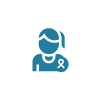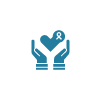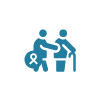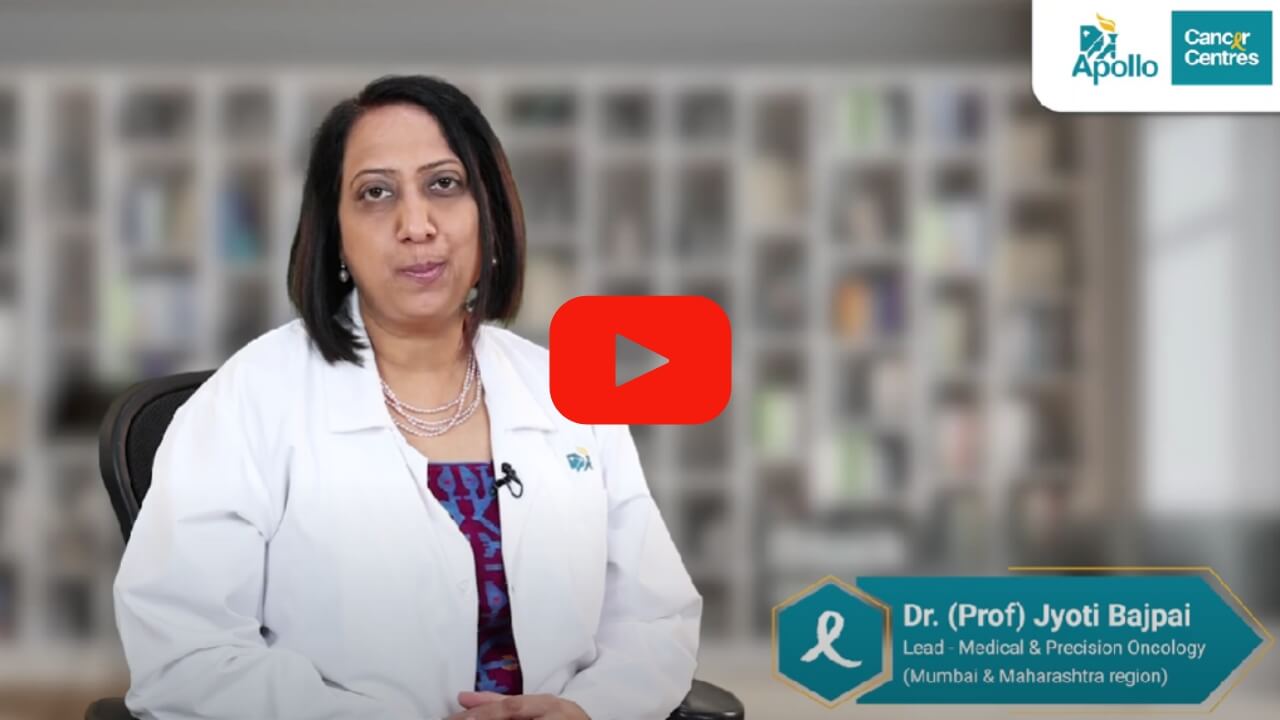RareCare Clinic
Your Partner in the Fight Against Rare Cancers & Rare Presentation of Common and/or Challenging Cancers!
The RareCare Clinic, a dedicated center at Apollo Hospitals specializing in the diagnosis, treatment, and care of rare cancers and rare presentations of common & cancers. We also address challenging issues such as comorbid conditions, extremes of age (both young and old), and pregnancy with and after cancers.

About Dr. Prof Jyoti Bajpai
Dr. (Prof) Jyoti Bajpai is the Lead - Medical & Precision Oncology (Mumbai & Maharashtra region) at Apollo Cancer Centers with 20 years of experience including 15 years as a Professor & Breast Cancer Convener at Tata Memorial Center.
She has completed her DM in Medical Oncology from AIIMS, New Delhi along with international training in Immuno-Oncology & Melanoma at Memorial Sloan Kettering Cancer Center, New York and Bone & Soft Tissue Sarcoma at Johns Hopkins University School of Medicine, Baltimore respectively.
Experience
- Dr. Bajpai is a specialist in Precision Medicine and Immunotherapy, renowned for expertise in Rare Cancers (including Bone and Soft tissue sarcomas, Skin cancers), Women’s Cancers (Breast and Gynecological), and cancers in advanced and challenging situations such as Pregnancy-associated cancers, Adolescents and Young Adult cancers, Geriatric cancers, and Cancer with co-morbid conditions.
- Dr. Bajpai worked in Tata Memorial Centre for 15 years a Professor of Medical Oncology & Breast Cancer Convener.
- Dr. Bajpai has held leadership positions in prestigious international societies, including serving as a core member of the Global Access & Impact Committee of the Society of Immunotherapy in Cancers (SITC) in the USA, a Faculty member for Immuno-Oncology at the European Society of Medical Oncology (ESMO), and as the immediate past faculty for Sarcomas, as well as a core committee member for Women for Oncology (W4O)-ESMO.
- An integral part of several national leading societies, Dr. Bajpai serves as the Founding General Secretary for the Immuno-Oncology Society of India (I-OSI), Joint Secretary for the Indian Society of Medical & Pediatric Oncology (ISMPO) and Teenage & Young Adult Cancer Foundation (TYAcan), and Chair for W4O India (under ISMPO) and SFO.
- As an avid researcher, Dr. Bajpai has published 200 papers in leading international and national journals of high impact, predominantly as the lead author. Her work has been presented at numerous international oncology conferences, where she has received awards for her focus on rare cancers (sarcomas, skin cancers, pregnancy-related cancers, LGBTQ+ cancers), women’s cancers, developing low-cost, efficacious protocols for low- and middle-income countries, workforce disparity, adolescent and young adult cancers, and Immuno-Oncology and Precision Medicine.
- Dr. Bajpai's involvement extends to various academic and research activities, including participation in international mentorship programs under ESMO, ASCO, and SFO, curriculum development for the HBNI fellowship Immuno-Oncology program, and providing thesis guidance for several students in India, the SAARC region, and other low- and middle-income countries.
Areas of interest
Rare cancers are typically defined as those with an incidence of fewer than 6 cases per 100,000 people per year. Despite their low frequency, they collectively represent a significant portion of all cancer cases. These cancers are often harder to diagnose due to their rarity, which can lead to delays in treatment and poorer prognoses.
Types of Rare and Challenging Cancers
- Pancreatic Cancer
- Pancreatic cancer is notorious for its poor prognosis and late detection. It often goes unnoticed until it reaches an advanced stage, making it one of the deadliest cancers.
- Symptoms include jaundice, abdominal pain, and weight loss. Treatment typically involves a combination of surgery, chemotherapy, and radiation, but new approaches such as targeted therapies and immunotherapy are being explored.
- Sarcomas
- Sarcomas are a diverse group of cancers originating from connective tissues like bone, muscle, and fat. They are classified into soft tissue sarcomas and bone sarcomas (e.g., osteosarcoma, Ewing sarcoma).
- Treatment usually involves surgery, radiation, and chemotherapy. Due to their varied nature, sarcomas often require highly individualized treatment plans.
- Brain Cancers (Glioblastoma Multiforme)
- Glioblastoma multiforme (GBM) is one of the most aggressive brain cancers, characterized by rapid growth and resistance to conventional therapies.
- Advances in neurosurgery, radiation therapy, and experimental treatments like tumor-treating fields and personalized vaccines are ongoing areas of research.
- Ocular Melanoma
- Ocular melanoma is a rare cancer that develops in the cells producing pigment in the eye. Early detection is challenging due to the lack of noticeable symptoms.
- Treatment options include radiation therapy, laser treatments, and enucleation (removal of the eye) in severe cases. Research into targeted therapies and genetic profiling is ongoing.
- Mesothelioma
- Mesothelioma is closely linked to asbestos exposure and affects the lining of the lungs, abdomen, or heart.
- It is difficult to treat due to its aggressive nature and resistance to standard treatments. Multimodal therapy combining surgery, chemotherapy, and radiation offers the best hope.
- Rare Pediatric Cancers
- Pediatric cancers, though rare, present unique challenges. Examples include neuroblastoma, Wilms tumor, and retinoblastoma.
- Pediatric oncology requires specialized treatment protocols, and research is focused on minimizing long-term side effects while improving survival rates.
Challenges in Treating Rare Cancers
- Lack of Research and Funding: Rare cancers receive less attention and funding compared to more common cancers, leading to gaps in knowledge and fewer clinical trials.
- Diagnostic Delays: Due to their rarity, symptoms of these cancers are often misdiagnosed or overlooked, resulting in delayed treatment.
- Limited Treatment Options: The scarcity of cases means fewer established treatment protocols and clinical guidelines, necessitating a more personalized approach to therapy.
- Access to Expertise: Patients with rare cancers often need to seek out specialized centers and experts, which may not be readily accessible.
Overview of Skin Cancer
Skin cancer is the most common type of cancer globally, arising from the uncontrolled growth of skin cells. It typically develops on skin exposed to the sun, but it can also occur in areas not typically exposed to sunlight. There are three main types of skin cancer:
- Basal Cell Carcinoma (BCC): The most common and least aggressive form, BCC originates in the basal cells of the skin and rarely spreads to other parts of the body.
- Squamous Cell Carcinoma (SCC): This type arises from squamous cells and can be more aggressive than BCC, with the potential to spread if not treated early.
- Melanoma: The most dangerous form of skin cancer, melanoma originates in melanocytes, the cells responsible for producing pigment in the skin. Melanoma is more likely to invade nearby tissues and spread to other parts of the body.
Risk Factors
Several risk factors contribute to the development of skin cancer, including:
- Ultraviolet (UV) Radiation: Prolonged exposure to UV radiation from the sun or tanning beds is the leading cause of skin cancer.
- Fair Skin: Individuals with lighter skin tones, who burn easily, are at a higher risk.
- Family History: A family history of skin cancer, particularly melanoma, increases the risk.
- Moles: Having a large number of moles or atypical moles can increase the risk of melanoma.
- Weakened Immune System: Individuals with compromised immune systems are more susceptible to skin cancer.
Symptoms
The symptoms of skin cancer can vary depending on the type and stage but commonly include:
- New Growths: The appearance of a new mole or skin lesion.
- Changes in Existing Moles: Changes in size, shape, color, or texture of a mole.
- Non-Healing Sores: Sores or lesions that do not heal over time.
- Itching or Bleeding: Moles or lesions that itch, bleed, or become painful.
Bone and soft tissue sarcomas are a group of rare cancers that arise from the connective tissues of the body, including bones, muscles, fat, nerves, and blood vessels. Among these, desmoid tumors, also known as aggressive fibromatosis, are a unique type of soft tissue sarcoma. Desmoid tumors are benign but locally aggressive tumors that do not metastasize to other parts of the body. However, they can invade surrounding tissues, leading to significant morbidity.
Characteristics of Desmoid Tumors
Desmoid tumors are characterized by the proliferation of fibroblastic cells, which are responsible for producing connective tissue. These tumors can occur anywhere in the body but are most commonly found in the abdomen, shoulders, arms, and legs. Although they are not malignant, desmoid tumors can be challenging to treat due to their tendency to recur after surgical removal.
Causes and Risk Factors
The exact cause of desmoid tumors is not fully understood, but they are associated with genetic mutations in the APC or CTNNB1 genes. These mutations can lead to the abnormal growth of fibroblasts. Desmoid tumors are also linked to familial adenomatous polyposis (FAP), a hereditary condition that increases the risk of developing multiple polyps in the colon and other tumors, including desmoid tumors. Trauma or surgical injury can sometimes trigger the growth of these tumors.
Symptoms
The symptoms of desmoid tumors vary depending on their location and size. Common symptoms include:
- Pain: Due to the tumor pressing on nerves or other structures.
- Swelling or a Lump: A noticeable mass may develop in the affected area.
- Restricted Movement: Tumors near joints or muscles can limit mobility.
- Bowel Obstruction: Tumors in the abdomen may cause intestinal blockage.
Pregnancy-related cancers, although rare, refer to cancers diagnosed during pregnancy or in the postpartum period, typically up to a year after childbirth. The incidence of cancer during pregnancy is estimated at about 1 in 1,000 pregnancies. Common types of cancers diagnosed during pregnancy include breast cancer, cervical cancer, lymphoma, melanoma, and thyroid cancer.
Types of Pregnancy-Related Cancers:
- Breast Cancer: The most common cancer during pregnancy, often diagnosed at a later stage due to the physiological changes in the breast tissue that can mask symptoms.
- Cervical Cancer: Often detected during routine prenatal screenings. The prognosis can be favorable if caught early.
- Melanoma: The risk of melanoma is not increased by pregnancy, but existing melanoma can progress more rapidly.
- Lymphoma: Both Hodgkin’s and non-Hodgkin’s lymphoma can occur during pregnancy, and treatment depends on the stage of pregnancy and the extent of the disease.
- Thyroid Cancer: Often detected through routine examinations. It generally has a good prognosis and can often be managed until after delivery if detected late in pregnancy.
Management During Pregnancy:
- Early Detection: Routine prenatal care and screenings are crucial for early detection.
- Multidisciplinary Team: Involvement of medical oncologist, surgeon, radiation oncologist, obstetricians, fetal medicine expert, genetic counselor and other specialists to tailor the best treatment plan.
- Patient Counseling: Providing thorough counseling to the patient and family about the risks, benefits, and potential outcomes of various treatment options.
- Delivery Planning: Timing of delivery may be adjusted based on the cancer treatment plan. In some cases, early delivery may be recommended to allow for more aggressive cancer treatment post-delivery.
Sexual minority populations, including lesbian, gay, bisexual, transgender, and queer (LGBTQ+) individuals, face unique challenges and disparities in cancer risk, diagnosis, treatment, and survivorship. These disparities arise from a combination of biological, behavioral, social, and healthcare access factors.
Cancer Risk Factors in LGBTQ+ Populations:
- Behavioral Risk Factors:
- Smoking: Higher rates of tobacco use among LGBTQ+ individuals, particularly in lesbian and bisexual women, increase the risk of cancers such as lung, head and neck, and esophageal cancer.
- Alcohol Use: Increased alcohol consumption can lead to higher risks of liver, breast, and other cancers.
- Diet and Exercise: Lower rates of physical activity and higher prevalence of obesity contribute to cancers such as colorectal and breast cancer.
- Human Papillomavirus (HPV) Infection:
HPV-Related Cancers: Higher rates of HPV infection, especially among men who have sex with men (MSM) and transgender individuals, increase the risk of anal, penile, cervical, and oropharyngeal cancers.
- HIV Infection:
Immunosuppression: HIV-positive individuals have a higher risk of cancers such as Kaposi sarcoma, non-Hodgkin lymphoma, and cervical cancer due to immunosuppression.
- Hormone Use:
Gender-Affirming Hormone Therapy: Transgender individuals undergoing hormone therapy may have increased risks of hormone-related cancers such as breast and prostate cancer, though data is still emerging.
Barriers to Healthcare:
- Stigma and Discrimination:
Healthcare Avoidance: Fear of discrimination leads many LGBTQ+ individuals to delay or avoid seeking medical care, resulting in later-stage cancer diagnoses.
Provider Knowledge and Sensitivity: Lack of culturally competent care and understanding of LGBTQ+ health needs among healthcare providers can result in inadequate cancer screening and treatment.
- Access to Health Insurance:
Insurance Disparities: LGBTQ+ individuals are less likely to have health insurance, impacting their ability to access preventive care and timely treatment.
- Mental Health:
Stress and Mental Health Disorders: Higher rates of stress, anxiety, and depression can impact cancer risk behaviors and adherence to treatment regimens.
Neuroendocrine tumors (NETs) are a diverse group of rare malignancies that arise from neuroendocrine cells, which are found throughout the body. These cells have characteristics of both nerve cells and hormone-producing endocrine cells, leading to the unique behavior of NETs. NETs can develop in various organs, including the gastrointestinal tract, pancreas, lungs, and less commonly, in other parts of the body. They can be benign or malignant and often present challenges in diagnosis and treatment due to their diverse locations and varied clinical presentations.
Types of Neuroendocrine Tumors
NETs are classified based on their site of origin and can be broadly categorized into the following types:
- Gastrointestinal NETs (GI-NETs): These tumors, also known as carcinoid tumors, are the most common type and can occur in the stomach, intestines, appendix, or rectum.
- Pancreatic NETs (pNETs): Arising from the pancreas, these tumors may produce hormones that cause distinct clinical syndromes, such as insulinomas, gastrinomas, and glucagonomas.
- Pulmonary NETs: These tumors develop in the lungs and include small-cell lung cancer (SCLC) and large-cell neuroendocrine carcinoma (LCNEC).
- Other NETs: NETs can also occur in other locations such as the adrenal glands (pheochromocytomas), thyroid (medullary thyroid cancer), and other organs.
Clinical Presentation
The symptoms of NETs vary widely depending on the tumor's location, size, and whether it produces hormones. Some NETs are "functioning," meaning they secrete hormones that can cause specific syndromes, while others are "non-functioning" and may not produce any symptoms until they grow large enough to cause mass effects.
- Gastrointestinal Symptoms: NETs in the digestive system may cause abdominal pain, diarrhea, or gastrointestinal bleeding.
- Hormonal Syndromes: Functioning NETs can lead to specific syndromes, such as Zollinger-Ellison syndrome (gastrinomas causing excessive acid production), or carcinoid syndrome (flushing, diarrhea, and wheezing due to serotonin overproduction).
- Non-specific Symptoms: Fatigue, unexplained weight loss, and loss of appetite may occur in more advanced stages.
Hereditary and familial cancers are cancers that occur due to genetic mutations passed down from one generation to the next or due to shared environmental and lifestyle factors within a family. These cancers account for 5-10% of all cancers and involve specific genes that, when mutated, significantly increase an individual's risk of developing certain types of cancer.
Genetics and Inheritance:
- Germline Mutations:
- Inherited Mutations: These are present in every cell of the body and can be passed from parents to their children. They can increase the risk of developing cancers at a younger age than typically observed.
- Common Syndromes: Hereditary cancers are often part of syndromes involving specific gene mutations, such as BRCA1 and BRCA2 in hereditary breast and ovarian cancer syndrome, or mutations in the APC gene in familial adenomatous polyposis (FAP).
- Autosomal Dominant Inheritance:
Single Gene Mutations: Most hereditary cancer syndromes are inherited in an autosomal dominant manner, meaning a mutation in just one copy of the gene from either parent is sufficient to increase cancer risk.
Common Hereditary Cancer Syndromes:
- Hereditary Breast and Ovarian Cancer Syndrome (HBOC):
- Genes Involved: BRCA1 and BRCA2.
- Associated Cancers: Increased risk of breast, ovarian, prostate, and pancreatic cancers.
- Risk Management: Enhanced surveillance, risk-reducing surgeries (e.g., mastectomy, oophorectomy), and chemoprevention.
- Lynch Syndrome (Hereditary Nonpolyposis Colorectal Cancer - HNPCC):
- Genes Involved: MLH1, MSH2, MSH6, PMS2, and EPCAM.
- Associated Cancers: Colorectal, endometrial, ovarian, gastric, small intestine, hepatobiliary tract, urinary tract, brain, and skin cancers.
- Risk Management: Regular colonoscopies, endometrial biopsies, and consideration of risk-reducing surgeries.
- Familial Adenomatous Polyposis (FAP):
- Gene Involved: APC.
- Associated Cancers: Colorectal cancer, duodenal, and other gastrointestinal cancers, as well as thyroid, liver, and other extracolonic cancers.
- Risk Management: Early and frequent colonoscopies, prophylactic colectomy, and surveillance for extracolonic tumors.
- Li-Fraumeni Syndrome:
- Gene Involved: TP53.
- Associated Cancers: A wide variety of cancers, including sarcomas, breast cancer, brain tumors, adrenocortical carcinoma, and leukemias.
- Risk Management: Comprehensive surveillance programs, including whole-body MRI.
- Familial Cancer Clusters:
Non-Syndromic Familial Cancer: Some families exhibit higher-than-average rates of certain cancers without a clearly defined hereditary syndrome. This clustering can be due to shared genetic, environmental, and lifestyle factors.
Genetic Testing and Counseling:
- Genetic Testing:
- Identifying Mutations: Testing individuals with a strong family history of cancer can identify specific gene mutations associated with increased cancer risk.
- Predictive Testing: Allows family members to determine their risk and consider preventive measures.
- Genetic Counseling:
- Informed Decisions: Genetic counselors provide information about the risks, benefits, and limitations of genetic testing.
- Support: Counseling helps individuals and families understand their risk and navigate decisions regarding surveillance, preventive measures, and family planning.
Risk Management:
- Surveillance:
- Regular Screening: Increased frequency of screenings for early detection, such as mammograms, colonoscopies, and MRIs.
- Tailored Programs: Surveillance programs are tailored based on specific gene mutations and associated cancer risks.
- Preventive Measures:
- Prophylactic Surgery: Risk-reducing surgeries, such as mastectomy or colectomy, to remove tissues at high risk of developing cancer.
- Chemoprevention: Use of medications to reduce cancer risk, such as tamoxifen for breast cancer prevention.
- Lifestyle Modifications:
Healthy Lifestyle: Adopting a healthy diet, regular exercise, avoiding tobacco, and limiting alcohol can help reduce overall cancer risk.
Adolescent and young adult (AYA) cancers refer to cancers that occur in individuals aged 15 to 39 years. This age group faces unique challenges, as they are at a transitional stage of life that includes physical, emotional, and social developments. Cancers in this group can differ from those in pediatric or older adult populations in terms of incidence, types, biology, treatment responses, and survivorship issues.
The overall cancer cases in the age group of 15–29 registered in five urban cancer registries in India were 5.8% of the total cancers.
Common Types of AYA Cancers:
- Hematologic Cancers:
- Leukemia: Acute lymphoblastic leukemia (ALL) and acute myeloid leukemia (AML) are common, with ALL being more prevalent in adolescents and AML in young adults.
- Lymphoma: Hodgkin lymphoma and non-Hodgkin lymphoma are frequent in the AYA group, with distinct subtypes and prognosis compared to other age groups.
- Solid Tumors:
- Breast Cancer: Although rare in this age group, breast cancer can occur and often presents with more aggressive features.
- Thyroid Cancer: More common in young adults, typically with a favorable prognosis but requiring long-term monitoring.
- Melanoma: The risk increases with age, and this group is particularly susceptible due to sun exposure behaviors.
- Sarcomas:
- Bone Sarcomas: Osteosarcoma and Ewing sarcoma are prevalent in adolescents and young adults.
- Soft Tissue Sarcomas: Such as rhabdomyosarcoma and synovial sarcoma.
- Germ Cell Tumors:
- Testicular Cancer: Common in young adult males, generally highly treatable with a good prognosis.
- Ovarian Germ Cell Tumors: Rare but can occur in adolescent and young adult females.
- Central Nervous System Tumors:
Brain Tumors: Gliomas, medulloblastomas, and other brain tumors can affect this age group, with varying prognoses.
Challenges and Issues:
- Delayed Diagnosis:
- Atypical Symptoms: Cancer symptoms in AYAs can be mistaken for less serious conditions, leading to delays in diagnosis.
- Healthcare Access: AYAs may have limited access to healthcare or may not prioritize routine health check-ups.
- Treatment Considerations:
- Fertility Preservation: Treatments such as chemotherapy and radiation can affect fertility, making preservation strategies crucial.
- Psychosocial Impact: The emotional and psychological toll of a cancer diagnosis can be significant, impacting education, career, relationships, and mental health.
- Treatment Adherence: AYAs may struggle with adherence to long-term treatment plans due to lifestyle, financial constraints, or lack of support.
- Survivorship and Long-Term Effects:
- Late Effects: Long-term survivors face risks of secondary cancers, cardiovascular issues, and other chronic health conditions due to treatment.
- Transition to Adult Care: AYAs often transition from pediatric to adult oncology care, requiring coordinated efforts to ensure continuity and quality of care.
While most breast and gynecological cancers are well-known and frequently encountered in clinical practice, some rare subtypes pose significant challenges in diagnosis, treatment, and management. These rare cancers often have distinct biological characteristics, making them more difficult to recognize and treat with conventional therapies. Understanding these rare varieties is crucial for improving outcomes through targeted therapies, personalized medicine, and awareness.
Rare Varieties of Breast Cancer
- Inflammatory Breast Cancer (IBC):
- Overview: IBC is a rare and aggressive form of breast cancer, accounting for about 1-5% of all breast cancers. Unlike more common types, it often does not present with a distinct lump. Instead, it manifests as redness, swelling, and warmth in the breast, often resembling an infection.
- Diagnosis: IBC is typically diagnosed through a combination of clinical examination, imaging studies, and biopsy. The rapid progression and unusual symptoms often lead to delayed diagnosis, which can complicate treatment.
- Treatment: Due to its aggressive nature, IBC is usually treated with a combination of chemotherapy, surgery, and radiation therapy. Targeted therapies and immunotherapies are also being explored as potential treatments.
- Triple-Negative Breast Cancer (TNBC):
- Overview: TNBC lacks estrogen, progesterone, and HER2 receptors, which are common targets for breast cancer therapies. This subtype is more common in younger women and certain ethnic groups, such as African Americans.
- Challenges: TNBC is particularly challenging to treat because it does not respond to hormone therapy or HER2-targeted treatments. It also tends to grow and spread faster than other types of breast cancer.
- Treatment: Chemotherapy is the mainstay of treatment for TNBC. Recently, immunotherapy and PARP inhibitors have shown promise in treating this aggressive subtype.
- Paget's Disease of the Breast:
- Overview: Paget's disease of the breast is a rare form of cancer that begins in the ducts of the nipple and spreads to the nipple’s skin and areola. It accounts for less than 5% of all breast cancer cases.
- Symptoms: Common symptoms include redness, flaking, and itching of the nipple, often resembling eczema. A lump may also be present in the breast.
- Treatment: Treatment typically involves surgery (mastectomy or breast-conserving surgery) combined with radiation therapy. Hormone therapy may be used if the underlying cancer is hormone receptor-positive.
Rare Varieties of Gynecological Cancers
- Ovarian Germ Cell Tumors:
- Overview: Ovarian germ cell tumors are rare, accounting for about 2-3% of all ovarian cancers. They originate from the cells that produce eggs and primarily affect younger women, often in their teens or twenties.
- Subtypes: These tumors include dysgerminomas, yolk sac tumors, and teratomas. Each subtype has distinct characteristics and requires different treatment approaches.
- Treatment: Treatment usually involves surgery to remove the tumor, followed by chemotherapy. Fertility-sparing surgery is often considered for younger patients.
- Clear Cell Carcinoma of the Ovary:
- Overview: Clear cell carcinoma is a rare and aggressive type of ovarian cancer, representing about 5-10% of cases. It is more common in women with a history of endometriosis.
- Challenges: This subtype is often resistant to standard platinum-based chemotherapy, leading to a poorer prognosis compared to other ovarian cancers.
- Treatment: Treatment involves surgery and chemotherapy, but the resistance to conventional therapies necessitates the exploration of targeted therapies and clinical trials.
- Vulvar Cancer:
- Overview: Vulvar cancer is a rare gynecological malignancy that accounts for about 4% of all female genital cancers. It typically affects older women, but cases in younger women have been associated with human papillomavirus (HPV) infection.
- Symptoms: Symptoms include itching, pain, and the presence of a lump or ulcer on the vulva. Early diagnosis is crucial for effective treatment.
- Treatment: Treatment typically involves surgery, which may include wide local excision, partial vulvectomy, or radical vulvectomy. Radiation and chemotherapy may be used in advanced cases.
- Uterine Sarcoma:
- Overview: Uterine sarcomas are rare, aggressive tumors that arise from the muscle or connective tissue of the uterus, accounting for less than 5% of all uterine cancers. They include leiomyosarcomas, endometrial stromal sarcomas, and carcinosarcomas.
- Symptoms: Symptoms may include abnormal uterine bleeding, pelvic pain, and a palpable mass. These tumors are often diagnosed at an advanced stage due to non-specific symptoms.
- Treatment: Treatment typically involves surgery, often followed by radiation or chemotherapy. The prognosis is generally poor due to the aggressive nature of these tumors.
Awards and certifications
- International:
- Global Access & Impact Committee core member - Society of Immunotherapy in Cancers (SITC), USA
- Faculty for Immuno - Oncology at European Society of Medical Oncology (ESMO)
- Immediate past faculty for Sarcomas - ESMO
- Core committee member for Women for Oncology (W4O) - ESMO
- Founder chair for Women for Oncology – SAARC (under SAARC Federation of Oncology (SFO)
- National:
- Founder General Secretary: Immuno - Oncology Society of India (IOSI)
- Executive member – Indian Society of Medical and Pediatric Oncology (ISMPO)
- Founder chair for Women for Oncology - India (under the banner of ISMPO)
- Founder Member and current Joint Secretary: Teenage and Young Cancer Association (TYAcan)
- Breast disease management group, Tata Memorial Centre – Convenor
Dr. Jyoti's Publications
- i) International Guideline Articles of Sarcoma:
- 1. Gronchi A, Miah AB, Dei Tos AP, Abecassis N, Bajpai J, Bauer Set al. ESMO Guidelines Committee, EURACAN and GENTURIS. Electronic address: clinicalguidelines@esmo.org. Soft tissue and visceral sarcomas: ESMO-EURACAN-GENTURIS Clinical Practice Guidelines for diagnosis, treatment and follow-up. Ann Oncol. 2021 Jul 22: S0923-7534(21)02184-0. doi: 10.1016/j.annonc.2021.07.006. https://pubmed.ncbi.nlm.nih.gov/34303806/
- 2. Strauss SJ, Frezza AM, Abecassis N, Bajpai J, Bauer S, Biagini R et al. Bone sarcomas: ESMO–EURACAN–GENTURIS–ERN Paed Can Clinical Practice Guideline for diagnosis, treatment and follow-up bone sarcomas. Ann Oncol. 2021 Dec;32(12):1520-1536. doi: 10.1016/j.annonc.2021.08.1995. Epub 2021 Sep 6. https://pubmed.ncbi.nlm.nih.gov/34500044/
- ii) Position Papers of Sarcoma:
- 1. Sacchiotti S. , Frezza A. M., Demetri G. D., BlayJ. Y. , Bajpai J., Baldiet G. al. Retrospective observational studies in ultra-rare sarcomas: A consensus paper from the Connective Tissue Oncology Society (CTOS) community of experts on the minimum requirements for the evaluation of activity of systemic treatments. Cancer Treat Rev.. 2022 Aug 18. https://pubmed.ncbi.nlm.nih.gov/36031697/
- iii) Osteosarcoma:
- 1. Bajpai J et.al. Osteosarcoma journey over two decades in India: Small steps, big changes; Pediatr Blood Cancer. 2019; e27877. https://doi.org/10.1002/pbc.27877
- 2. Bajpai J et.al. Outcomes in Treatment-Naïve Patients with Metastatic Extremity Osteosarcoma Treated with OGS-12, a Novel Non–High-Dose Methotrexate–Based, Dose-Dense Combination Chemotherapy, in a Tertiary Care Cancer Center; Journal of Global Oncology.2018. (4):1-10. https://www.ncbi.nlm.nih.gov/pmc/articles/PMC6223433/
- 3. Bajpai J et.al. Outcomes in non-metastatic extremity osteosarcoma patients treated with a novel non-high dose methotrexate based dose dense combination chemotherapy regimen “OGS-12”. Eur J Cancer. 2017 Nov; 85:49-58. https://pubmed.ncbi.nlm.nih.gov/28888849/
- 4. Sujith M, Bajpai J et al. Pazopanib in advanced soft tissue sarcomas: first data from India. ISMPO con New Delhi, November 2016. https://pubmed.ncbi.nlm.nih.gov/33753596/
- 5. Bajpai J., Gamnagatti S., Kumar R. et al. Role of MRI in osteosarcoma for evaluation and prediction of chemotherapy response: correlation with histological necrosis. PediatrRadiol 41, 441–450 (2011). https://doi.org/10.1007/s00247-010-1876-3
- 6. Bajpai J et.al. Chemotherapy compliance in patients with osteosarcoma. Pediatric Blood Cancer. 2013 Jan; 60(1):41-4. https://pubmed.ncbi.nlm.nih.gov/22488836/
- 7. Bajpai J. et.al; Noninvasive Imaging Surrogate of Angiogenesis in Osteosarcoma. Pediatric blood and cancer journal; Volume54, Issue4, April 2010 Pages 526-531; 03 November 2009; https://doi.org/10.1002/pbc.22328
- 8. Bajpai J et.al. VEGF Expression as a Prognostic Marker in Osteosarcoma. Pediatric Blood Cancer 2009; 53:1035–1039. https://pubmed.ncbi.nlm.nih.gov/19621435/
- 9. Bajpai J, Jaffe N. Perspectives of the Role of Chemotherapy in the Management of Osteosarcoma. Journal of Cancer Therapy .2012, 3,1911-1203 http://dx.doi.org/10.4236/jct.2012.36154
- 10. Bajpai J, et.al. Targeted Therapy of Soft Tissue Sarcoma: There is More than one Way to Skin a Cat! Chemo Open Access 2016. 5: 216. doi:10.4172/2167-7700.1000216
- 11. Chandrakanth MV, Bajpai J. (corresponding author) Compliance to Therapy as a Prognostic Marker in Osteosarcoma: New Kid on the Block! DiagnPathol Open 2016. 1:119. DOI: 10.4172/2476-2024.1000119
- 12. Rekhi B, Bajpai J, Puri A. Clinicopathologic features of undifferentiated round cell sarcomas of bone & soft tissues: An attempt to unravel the BCOR-CCNB3- & CIC-DUX4-positive sarcomas [published correction appears in Indian J Med Res. 2020 Sep;152(3):323]. Indian J Med Res. 2019;150(6):557-574. doi: 10.4103/ijmr.IJMR_2144_18 https://www.ncbi.nlm.nih.gov/pmc/articles/PMC7038815/
- 13. Bajpai J, Patel S. Sarcomas: Difficult to tame tumors! South Asian J Cancer 2016; 5: Issue 3,137-8. https://www.ncbi.nlm.nih.gov/pmc/articles/PMC4991134/
- iv) Ewing's Sarcoma:
- 1. Pandaet G. al (Bajpai J –corresponding author). Outcomes of Ewing sarcoma in adults over 40 years of age from a low-middle income country. https://doi.org/10.3332/ecancer.2022.1361
- 2. Sekharan K. V., Ramanathan S., Chinnaswamy G., Bajpai J.,et.al. High Response Rates and Promising Outcomes of Patients with Relapsed Ewing Sarcoma, Especially in Adolescents and Young Adults Treated on a Novel Hybrid Salvage Chemotherapy Regimen; Journal of Adolescent and Young Adult Oncology VOL. 10, No. 2; 15 Apr 202. https://doi.org/10.1089/jayao.2020.0016
- 3. Bajpai J., Panda G. S.,Chandrasekharan A., et.al. Adolescent–adult non metastatic Ewing sarcoma—Experience from a large developing country; Paediatric Blood and Cancer Journal; Volume68, Issue9, September 2021, e29081; 15 May 2021. https://doi.org/10.1002/pbc.29081
- 4. Sharda M, Bajpai J et.al. (corresponding author). Widely Disseminated Metastatic Ewing sarcoma: Sustained, Complete Metabolic Response to First-Line Oral Metronomic Chemotherapy. https://onlinelibrary.wiley.com/doi/10.1002/pbc.28375
- 5. Khanna N, Pandey A, Bajpai J (corresponding author). Metastatic Ewing's Sarcoma: Revisiting the "Evidence on the Fence". Indian J Med Paediatr Oncol https://pubmed.ncbi.nlm.nih.gov/28900327/
- v) Other Sarcomas:
- 1. Rekhi B, Shetty O, Ramadwar M, Rangarajan V, Bajpai J. Role of fine needle aspiration cytology in the diagnosis of a rare case of a poorly differentiated synovial sarcoma with "Rhabdoid" features, including treatment implications.DiagnCytopathol. 2017 Jul;45(7):662-667. doi: 10.1002/dc.23712. Epub 2017 Mar 27. https://pubmed.ncbi.nlm.nih.gov/28345284/
- 2. Rekhi B, Ramavdhar M, Bajpai J Extraskeletal Myxoid Chondrosarcomas Are Not Characterized by Loss of INI1/SMARCB1: Immuno histochemical Analysis of 16 Cases. J Carcinogen Mutagen 8:280. 2017. Doi:10.4172/2157-2518.1000280
1. Bajpai J et.al. Demographics, Pattern of Care, and Outcome Analysis of Malignant Melanomas - Experience from a Tertiary Cancer Centre in India. Front. Oncol, 08 September 2021 https://doi.org/10.3389/fonc.2021.710585
2. Bajpai J, Kapoor A, Jalali R, Gounder M. Checkpoint inhibitors and radiotherapy in refractory malignant melanocytic schwannoma with Carney complex: first evidence of efficacy BMJ Case Rep 2021;14: e240296. doi:10.1136/bcr-2020- 240296. https://casereports.bmj.com/content/14/5/e240296
3. Sahay A., Epari S., Gupta P., Bajpai J. et al. Melanotic Schwannoma, a Deceptive Misnomer for a Tumor with Relative Aggressive Behavior: A Series of 7 Cranial and Spinal Cases. International Journal of Surgical Pathology. 2020; 28 (8): 850-858 doi:10 . 1177 /1066896920923146. https://pubmed.ncbi.nlm.nih.gov/32456496/
- i) Breast Cancer:
- 1. Bajpai J. et.al. Unique challenges and outcomes of young breast cancers from a tertiary care cancer centre in India. Annals of Oncology. https://pubmed.ncbi.nlm.nih.gov/34655887/
- 2. Bajpai J et.al. Outcomes of non-metastatic triple negative breast cancers: Real-world data from a large Indian cohort. Breast. 2022;63:77-84. doi:10.1016/j.breast.2022.03.011. https://www.ncbi.nlm.nih.gov/pmc/articles/PMC8942859/
- 3. Bajpai J, Kapu V, Rath S et al, Low-dose versus standard-dose olanzapine with triple antiemetic therapy for prevention of highly emetogenic chemotherapy-induced nausea and vomiting in patients with solid tumours: a single-centre, open-label, non-inferiority, randomised, controlled, phase 3 trial. The Lancet Oncology, Volume 25, Issue 2, 2024, Pages 246-254, ISSN 1470-2045, https://doi.org/10.1016/S1470-2045(23)00628-9
- 4. Bajpai J et.al. "Randomised controlled trial of scalp cooling for the prevention of chemotherapy induced alopecia". Breast. 2019 Dec 12; 49:187-193. doi: 10.1016/j.breast.2019.12.004. https://pubmed.ncbi.nlm.nih.gov/31865282/
- 5. Lambertini M, Blondeaux E, Agostinetto E, Bajpai J et al. Pregnancy After Breast Cancer in Young BRCA Carriers: An International Hospital-Based Cohort Study. JAMA. 2024;331(1):49-59. doi:10.1001/jama.2023.25463. https://pubmed.ncbi.nlm.nih.gov/38059899/
- 6. Bajpai J. et.al. Pregnancy-associated breast cancer (PABC): Demographics and outcome analysis from a lower and middle income country (LMIC). Annals of Oncology (2020) 31 (suppl_2): S54-S57. 10.1016/annonc/annonc120. https://pubmed.ncbi.nlm.nih.gov/33640524/
- ii) Pregnancy related Cancers:
- 1. Mailankody S, Bajpai J (co-first and corresponding author) et al. Oncofertility and Pregnancy in Adolescent and Young Adult Cancers: Physicians' Knowledge and Preferences in India. JCO Glob Oncol. https://www.ncbi.nlm.nih.gov/pmc/articles/PMC10793988/
- 2. Lambertini M, Blondeaux E, Agostinetto E, Bajpai J et al. Pregnancy After Breast Cancer in Young BRCA Carriers: An International Hospital-Based Cohort Study. JAMA. 2024;331(1):49-59. doi:10.1001/jama.2023.25463. https://pubmed.ncbi.nlm.nih.gov/38059899/
- iii) Sarcomas:
- 1. Sekharan K. V., Ramanathan S., Chinnaswamy G., Bajpai J.,et.al. High Response Rates and Promising Outcomes of Patients with Relapsed Ewing Sarcoma, Especially in Adolescents and Young Adults Treated on a Novel Hybrid Salvage Chemotherapy Regimen; Journal of Adolescent and Young Adult Oncology VOL. 10, No. 2; 15 Apr 2021. https://doi.org/10.1089/jayao.2020.0016
- 2. Bajpai J., Panda G. S.,Chandrasekharan A., et.al. Adolescent–adult non metastatic Ewing sarcoma—Experience from a large developing country; Paediatric Blood and Cancer Journal; Volume68, Issue9, September 2021, e29081; 15 May 2021. https://doi.org/10.1002/pbc.29081
- 3. Sekharan K. V., Ramanathan S., Chinnaswamy G., Bajpai J.,et.al. High Response Rates and Promising Outcomes of Patients with Relapsed Ewing Sarcoma, Especially in Adolescents and Young Adults Treated on a Novel Hybrid Salvage Chemotherapy Regimen; Journal of Adolescent and Young Adult Oncology VOL. 10, No. 2; 15 Apr 2021. https://doi.org/10.1089/jayao.2020.0016
- 1.Srinivas S, Bajpai J. Immunotherapy in special and rare situations: a brief review. J Immunother Precis Oncol. Published online. DOI: 10.36401/JIPO-21-6. https://www.ncbi.nlm.nih.gov/pmc/articles/PMC9138482/
- 2. Bajpai J. Cancer Immunotherapy for immuno compromised Patients: An Often Ignored, yet Vital Puzzle. Journal of Immunotherapy and Precision Oncology (2020)3 (1): 1–2. https://doi.org/10.4103/2666-2345.278414
- 3. Disis M, Adams SF, Bajpai J et al. Society for Immunotherapy of Cancer (SITC) clinical practice guideline on immunotherapy for the treatment of gynecologic cancer. The Journal for Immunotherapy of Cancer (JITC). https://jitc.bmj.com/content/11/6/e006624
- 4. Abraham G et al. (Bajpai J- corresponding author)."The clinical utility and safety of Short Course Immune check point inhibitors (ICI) in multiple tumors - A real world multicentric study from India". International Journal of Cancer. Int J Cancer. 2022 Mar 15;150(6):1045-1052. doi: 10.1002/ijc.33868. Epub 2021 Nov 25. PMID: 34751432. https://onlinelibrary.wiley.com/doi/abs/10.1002/ijc.33868
- 1. Lambertini M, Blondeaux E, Agostinetto E, Bajpai J et al. Pregnancy After Breast Cancer in Young BRCA Carriers: An International Hospital-Based Cohort Study. JAMA. 2024;331(1):49-59. doi:10.1001/jama.2023.25463. https://pubmed.ncbi.nlm.nih.gov/38059899/
- 2 .Bajpai J. et.al. Pregnancy-associated breast cancer (PABC): Demographics and outcome analysis from a lower and middle income country (LMIC). Annals of Oncology (2020) 31 (suppl_2): S54-S57. 10.1016/annonc/annonc120. https://pubmed.ncbi.nlm.nih.gov/33640524/
- 3. Mailankody S, Bajpai J (co-first and corresponding author) et al. Oncofertility and Pregnancy in Adolescent and Young Adult Cancers: Physicians' Knowledge and Preferences in India. JCO Glob Oncol. doi:10.1200/GO.23.00205. https://www.ncbi.nlm.nih.gov/pmc/articles/PMC10793988/
- 1. Bajpai J, Kapu V, Rath S et al, Low-dose versus standard-dose olanzapine with triple antiemetic therapy for prevention of highly emetogenic chemotherapy-induced nausea and vomiting in patients with solid tumours: a single-centre, open-label, non-inferiority, randomised, controlled, phase 3 trial. The Lancet Oncology, Volume 25, Issue 2, 2024, Pages 246-254, ISSN 1470-2045, https://doi.org/10.1016/S1470-2045(23)00628-9
- 2. Bajpai J et.al. "Randomised controlled trial of scalp cooling for the prevention of chemotherapy induced alopecia". Breast. 2019 Dec 12; 49:187-193. doi: 10.1016/j.breast.2019.12.004. https://pubmed.ncbi.nlm.nih.gov/31865282/
Why Choose RareCare Clinic at Apollo Hospitals Navi Mumbai?
Expert Multidisciplinary Team: Our lead medical oncologist, along with surgeons, radiation oncologists, lab experts, and researchers, work together to provide personalized treatment plans.
Cutting-Edge Technology: Utilizing the latest advancements in genomic profiling, immunotherapy, and targeted treatments.
Comprehensive Support: Holistic care that addresses physical, emotional, and psychological needs.
Frequently Asked Questions
Rare cancers are those that affect a small percentage of the population. Typically, they are defined as cancers with an incidence rate of fewer than 6 cases per 100,000 people per year. Examples include mesothelioma, certain types of sarcomas, and cancers of the endocrine system.
The Diagnosis of rare cancers involves multiple methods, including assessing medical history and physical exams, using imaging tests like CT scans, MRIs, and PET scans to visualize the tumor, performing biopsies for microscopic examination, and conducting molecular and genetic testing to identify specific genetic mutations or markers. This comprehensive approach ensures accurate identification and effective treatment planning.
Diagnosing rare cancers is challenging due to a lack of awareness among both patients and primary care physicians, which can result in unrecognized symptoms. Additionally, standard diagnostic tools may not effectively identify rare cancers, and the symptoms often mimic more common conditions, leading to frequent misdiagnoses and delays in proper diagnosis.
Treatment options depend on the specific type and stage of the cancer and may include:
- Surgery: To remove the tumor.
- Radiation Therapy: Using high-energy rays to destroy cancer cells.
- Chemotherapy: Using drugs to kill cancer cells.
- Targeted Therapy: Drugs that target specific genetic mutations in cancer
cells.
- Immunotherapy: Boosting the body's immune system to fight cancer.
Patients should seek treatment at major cancer centers or hospitals that specialize in rare cancers. These centers often have multidisciplinary teams that include oncologists, surgeons, radiologists, and other specialists with experience in treating rare cancers.

















